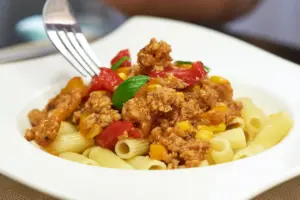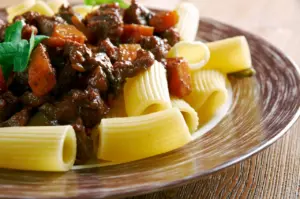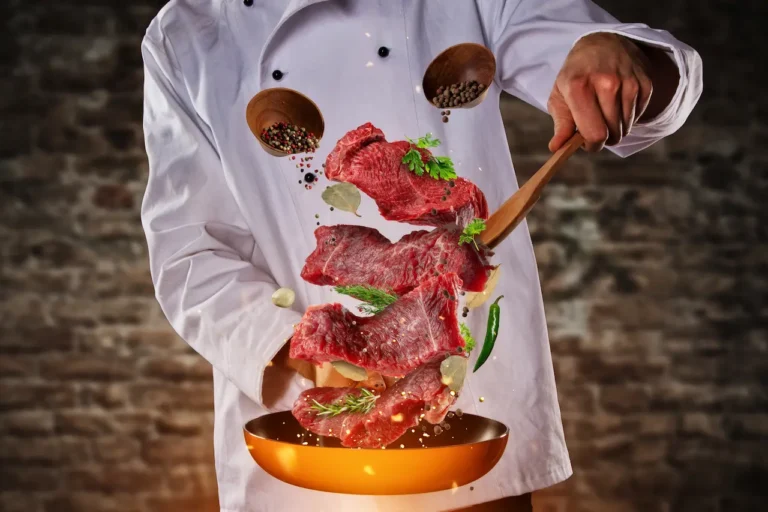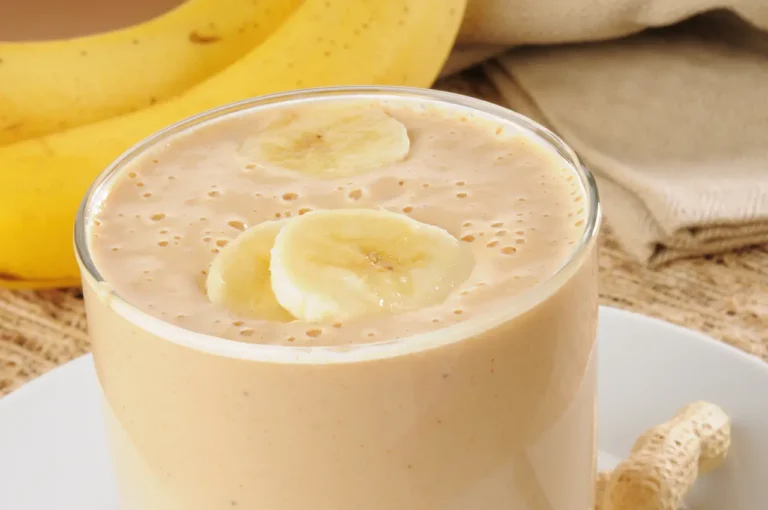Pasta alla Genovese

Make ragu with beef and onions. This is “la Genovese,” the classic Neapolitan Sugo. It’s not Ligurian despite the name. The sauce is made with carrots, celery and a seconda scelta (literally “second choice” cut) of beef. This “tough” piece of meat, also known as “second choice”, is cooked slowly in white wine, forming a rich gravy that’s perfect for topping al dente pasta from Gragnano – the dried pasta capital in Italy. La Genovese, unlike its meat-filled Campanian cousin Ragu Napoletano, is a simple dish.
Ingredients
- Boneless beef chuck, 1 1/2 pounds (700g), trimmed into 4 by 3-inch pieces
- Black pepper and Kosher Salt
- Use 1/4 cup of extra virgin olive oil or lard (60g).
- Peeled and diced carrots, 3 1/2 ounces or 100g (2 small carrots).
- Celery ribs (75g) trimmed into small dice
- Yellow or red onions, 3 pounds (1.4kg), thinly sliced and divided
- 1 tablespoon (15g), tomato paste
- Divide 1 cup (240ml), of dry white wine into 4 equal portions.
- 1 Bay Leaf
- Cherry tomatoes, 5 ounces (150g), optional (see note).
- Ziti, Paccheri, or Rigatoni are all short tube-dried pasta that weighs 1 pound (450g).
- Fresh parsley leaves, tender stems, and 1 loosely packed cup (15g; 1/2 ounce) of fresh parsley leaves.
- For serving, finely grated Parmigiano-Reggiano or Pecorino Romano.
Instruction
- Salt and pepper the beef on all sides; let it sit for 45 minutes.
- In a large Dutch Oven, heat the lard, or olive oil, over a medium-high flame until it shimmers. Stirring occasionally, add celery and carrots, and cook until softened, but not brown, for about 5 minutes. Add about 1/3 of the onion (about 1 pound, 450g), season with salt, and continue cooking, stirring occasionally until onions are softened, but not browned.
- Add 1/4 cup wine and tomato paste. Stir and scrape with a wooden spatula on the bottom and sides to remove any stuck-on bits. Spread the onion mixture in an even layer to cover the bottom of the pan. Reduce heat to medium and add the beef. Nestle pieces in onion mixture, in one layer. Cover remaining onions with beef (about 2 pounds, 900g), season with salt, and add bay leaf. Cover the pot with a lid.
- Stirring and uncovering the pot to make sure vegetables and beef don’t stick to the bottom is important. Cook until onions have become very soft and released moisture. This should take about an hour. As needed, adjust the heat to maintain a simmering, gentle temperature. Try to keep an onion layer between the bottom of the pot and beef.
- Continue to cook the beef until it is tender and offers little resistance when poked or pressed with wooden spoons, approximately 1 hour 30 minutes more. Remove the beef and bay leaves with tongs. Set aside to allow beef to cool and then discard bay leaf.
- Add the remaining 3/4 cup of wine (180ml), and cherry tomatoes if you are using them, to the onion mixture. Bring to a simmer on medium heat. When beef is cool enough for you to handle, slice it into 1-1/2-inch pieces. Add back to the pot. Salt to taste, and continue to cook, stirring frequently, until the tomatoes burst, and the mixture has reduced to a saucey braised ragu, approximately 15 minutes. Prod the pieces of beef with a wooden teaspoon to break them down a little. But don’t go overboard. The goal is a mixture that includes distinct pieces of meat and some shredded bits blending into the sauce.
- In a pot with salted boiling, cook the pasta for 1 to 2 minutes longer than recommended on the package. Transfer pasta and 1/2 cup (120ml), pasta cooking water, to the sauce using a spider skimmer. You can also drain the pasta in a fine-mesh sieve or colander, reserving at least one cup (240ml).
- Stirring rapidly, increase heat to high. Cook, stirring quickly, for 1 to 2 min. until pasta is cooked al dente, and the sauce thickens and coats the noodles. Add more pasta water as required, in increments of 1/4 cup (60ml). Add parsley and quickly stir to combine. Remove from heat. Add salt to your taste. Serve immediately and pass the grated cheese to the table.
La Genovese, like ragu Napoletano or many other Central and Southern Italian sauces that are based on meat, was traditionally a recipe that allowed cooks the opportunity to extend a braise across multiple meals and courses. The idea is simple: Braise meat slowly with aromatics, until it becomes tender. Use the braising liquid to dress pasta (or polenta, in some areas) while serving the meat separately.
Table of Contents
ToggleItalian-American Sunday gravy is a product of the cucina povera. It stands in stark contrast with ragus that are made in historically wealthier regions of northern Italy. For example, ragu ala Bolognese uses a combination of ground meats, along with butter, Parmigiano Reggiano, and cream or milk. As meat became more affordable in the South, it was added to the pasta sauce. Today, the meat sauce is made from the braised beef.

Pasta alla Genovese
Ingredients
- 1 1/2 pounds (700g) Boneless beef chuck (trimmed into 4 by 3-inch pieces)
- Black pepper and Kosher Salt
- 14 cup extra virgin olive oil or lard
- 3 1/2 oz carrots (peeled and diced)
- 1 Celery ribs (75g) (peeled and cut into small dice)
- 3 pounds (1.4kg) yellow or red onions (thinly sliced and divided)
- 1 tbsp tomato paste
- 1 cup dry white wine (divided)
- 1 bay leaf
- 5 oz (150g) cherry tomatoes (optional)
- 1 pound (450g) short tubular dried pasta (such as ziti, paccheri, or rigatoni)
- 1 cup Fresh parsley leaves and tender stems (finely chopped)
- Parmigiano-Reggiano or Pecorino Romano (finely grated)
Method
- Salt and pepper the beef on all sides; let it sit for 45 minutes.
- In a large Dutch Oven, heat the lard, or olive oil, over a medium-high flame until it shimmers. Stirring occasionally, add celery and carrots, and cook until softened, but not brown, for about 5 minutes. Add about 1/3 of the onion (about 1 pound, 450g), season with salt, and continue cooking, stirring occasionally until onions are softened, but not browned.
- Add 1/4 cup wine and tomato paste. Stir and scrape with a wooden spatula on the bottom and sides to remove any stuck-on bits. Spread the onion mixture in an even layer to cover the bottom of the pan. Reduce heat to medium and add the beef. Nestle pieces in onion mixture, in one layer. Cover remaining onions with beef (about 2 pounds, 900g), season with salt, and add bay leaf. Cover pot with a lid.
- Stirring and uncovering the pot to make sure vegetables and beef don't stick to the bottom is important. Cook until onions have become very soft and released moisture. This should take about an hour. As needed, adjust the heat to maintain a simmering, gentle temperature. Try to keep an onion layer between the bottom of the pot and beef.
- Continue to cook the beef until it is tender and offers little resistance when poked or pressed with wooden spoons, approximately 1 hour 30 minutes more. Remove the beef and bay leaves with tongs. Set aside to allow beef to cool and then discard bay leaf.
- Add the remaining 3/4 cup of wine (180ml), and cherry tomatoes if you are using them, to the onion mixture. Bring to a simmer on medium heat. When beef is cool enough for you to handle, slice it into 1-1/2-inch pieces. Add back to the pot. Salt to taste, and continue to cook, stirring frequently, until the tomatoes burst, and the mixture has reduced to a saucey braised ragu, approximately 15 minutes. Prod the pieces of beef with a wooden teaspoon to break them down a little. But don't go overboard. The goal is a mixture that includes distinct pieces of meat and some shredded bits blending into the sauce.
- In a pot with salted boiling, cook the pasta for 1 to 2 minutes longer than recommended on the package. Transfer pasta and 1/2 cup (120ml), pasta cooking water, to the sauce using a spider skimmer. You can also drain the pasta in a fine-mesh sieve or colander, reserving at least one cup (240ml).
- Stirring rapidly, increase heat to high. Cook, stirring quickly, for 1 to 2 min. until pasta is cooked al dente, and the sauce thickens and coats the noodles. Add more pasta water as required, in increments of 1/4 cup (60ml). Add parsley and quickly stir to combine. Remove from heat. Add salt to your taste. Serve immediately and pass the grated cheese to the table.



